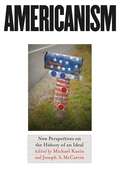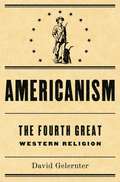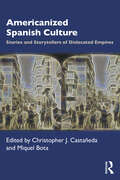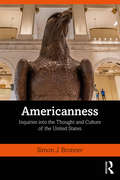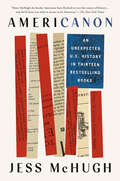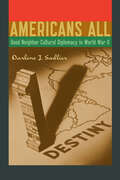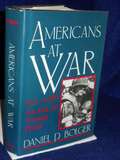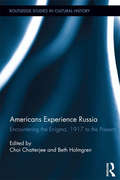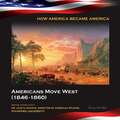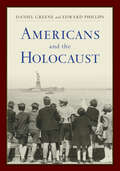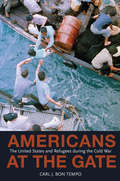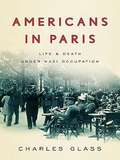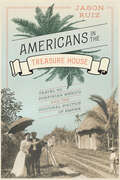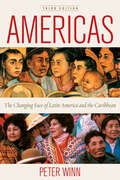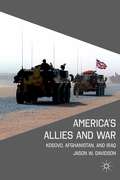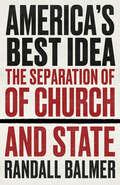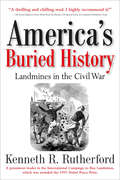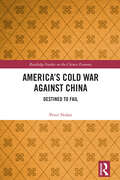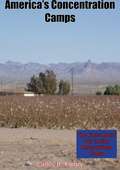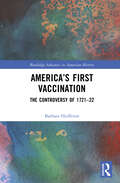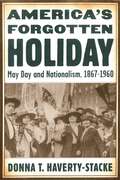- Table View
- List View
Americanism
by Michael Kazin Joseph A. MccartinWhat is Americanism? The contributors to this volume recognize Americanism in all its complexity--as an ideology, an articulation of the nation's rightful place in the world, a set of traditions, a political language, and a cultural style imbued with political meaning. In response to the pervasive vision of Americanism as a battle cry or a smug assumption, this collection of essays stirs up new questions and debates that challenge us to rethink the model currently being exported, too often by force, to the rest of the world.Crafted by a cast of both rising and renowned intellectuals from three continents, the twelve essays in this volume are divided into two sections. The first group of essays addresses the understanding of Americanism within the United States over the past two centuries, from the early republic to the war in Iraq. The second section provides perspectives from around the world in an effort to make sense of how the national creed and its critics have shaped diplomacy, war, and global culture in the twentieth and twenty-first centuries. Approaching a controversial ideology as both scholars and citizens, many of the essayists call for a revival of the ideals of Americanism in a new progressive politics that can bring together an increasingly polarized and fragmented citizenry.Contributors:Mia Bay, Rutgers UniversityJun Furuya, Hokkaido University, JapanGary Gerstle, University of MarylandJonathan M. Hansen, Harvard UniversityMichael Kazin, Georgetown UniversityRob Kroes, University of AmsterdamMelani McAlister, The George Washington UniversityJoseph A. McCartin, Georgetown UniversityAlan McPherson, Howard UniversityLouis Menand, Harvard UniversityMae M. Ngai, University of ChicagoRobert Shalhope, University of OklahomaStephen J. Whitfield, Brandeis UniversityAlan Wolfe, Boston CollegeWhat is Americanism? The contributors to this volume recognize Americanism in all its complexity--as an ideology, an articulation of the nation's rightful place in the world, a set of traditions, a political language, and a cultural style imbued with political meaning. In response to the pervasive vision of Americanism as a battle cry or a smug assumption, this collection of essays stirs up new questions and debates that challenge us to rethink the model currently being exported, too often by force, to the rest of the world.Approaching a controversial ideology as both scholars and citizens, many of the essayists call for a revival of the ideals of Americanism in a new progressive politics that can bring together an increasingly polarized and fragmented citizenry. The contributors are Mia Bay, Jun Furuya, Gary Gerstle, Jonathan M. Hansen, Michael Kazin, Rob Kroes, Melani McAlister, Joseph A. McCartin, Alan McPherson, Louis Menand, Mae M. Ngai, Robert Shalhope, Stephen J. Whitfield, and Alan Wolfe. The editors are Michael Kazin and Joseph A. McCartin.-->
Americanism: The Fourth Great Western Religion
by David GelernterWhat does it mean to "believe" in America? Why do we always speak of our country as having a mission or purpose that is higher than other nations? Modern liberals have invested a great deal in the notion that America was founded as a secular state, with religion relegated to the private sphere. David Gelernter argues that America is not secular at all, but a powerful religious idea--indeed, a religion in its own right. Gelernter argues that what we have come to call "Americanism" is in fact a secular version of Zionism. Not the Zionism of the ancient Hebrews, but that of the Puritan founders who saw themselves as the new children of Israel, creating a new Jerusalem in a new world. Their faith-based ideals of liberty, equality, and democratic governance had a greater influence on the nation's founders than the Enlightenment. Gelernter traces the development of the American religion from its roots in the Puritan Zionism of seventeenth-century New England to the idealistic fighting faith it has become, a militant creed dedicated to spreading freedom around the world. The central figures in this process were Abraham Lincoln, Teddy Roosevelt, and Woodrow Wilson, who presided over the secularization of the American Zionist idea into the form we now know as Americanism. If America is a religion, it is a religion without a god, and it is a global religion. People who believe in America live all over the world. Its adherents have included oppressed and freedom-loving peoples everywhere--from the patriots of the Greek and Hungarian revolutions to the martyred Chinese dissidents of Tiananmen Square. Gelernter also shows that anti-Americanism, particularly the virulent kind that is found today in Europe, is a reaction against this religious conception of America on the part of those who adhere to a rival religion of pacifism and appeasement. A startlingly original argument about the religious meaning of America and why it is loved--and hated--with so much passion at home and abroad.
Americanized Spanish Culture: Stories and Storytellers of Dislocated Empires
by Christopher J. CastañedaAmericanized Spanish Culture explores the intricate transcultural dialogue between Spain and the United States since the late 19th century. The term "Americanized" reflects the influence of American cultural traits, ideas, and tendencies on individuals, institutions, and creative works that have moved back and forth between Spain and the United States. Although it is often defined narrowly as the result of a process of cultural imperialism, colonization, assimilation, and erasure, this book uses the term more expansively to explore representations of the transcultural mixing of Spanish and American culture in which the American influence might seem dominant but may also be the one that is shaped. The chapters in this volume highlight the lives of fascinating individuals, ideologies, and artistry that represent important themes in this transnational relationship of dislocated empires. The contributors represent a wide array of perspectives and life experiences, giving breadth, depth, and realism to their observations and analysis. Organized in two parts of five chapters each, this volume offers a unique perspective on the intermixing and intermingling of Spanish and American social, cultural, and literary traits and characteristics. This book will be of interest to students of United States and Spanish history, Iberian and Hispanic American studies, and cultural studies.
Americanness: Inquiries into the Thought and Culture of the United States
by Simon J. BronnerAmericanness: Inquiries into the Thought and Culture of the United States analyzes several core themes that connect Americans because of, and despite, their pronounced diversity. The book investigates shared ideas and ideals, such as individualism, mobility, materialism, and future-orientation, that drive an overarching American worldview. Simon J. Bronner begins with ideas of space and time as they formed and changed through the history of the United States, before moving to the emergence of modern American culture. He examines reasons America is characterized as having a "victory culture" that extends to the American legal, military, and business complexes. This victory culture is further analyzed by looking at the country’s relationship with the game of football—a sport that thrives in America but has not caught on in other countries. Finally, the volume probes American consumerism driven by a desire for individual prosperity in a supposedly egalitarian society. Using interdisciplinary approaches drawn from psychology, sociology, ethnology, and history, Bronner seeks explanations for people invoking, and evoking, ideas that they perceive as American. This book would be an invaluable addition to courses on American history, sociology, cultural studies, and American studies.
Americanon: An Unexpected U.S. History in Thirteen Bestselling Books
by Jess McHugh&“An elegant, meticulously-researched and eminently readable history of the books that define us as Americans. For history buffs and book-lovers alike, McHugh offers us a precious gift.&”—Jake Halpern, Pulitzer Prize Winner and New York Times Bestselling author &“With her usual eye for detail and knack for smart storytelling, Jess McHugh takes a savvy and sensitive look at the 'secret origins' of the books that made and defined us…. You won't want to miss a one moment of it.&”—Brian Jay Jones, author of Becoming Dr. Seuss and the New York Times Bestselling Jim HensonThe true, fascinating, and remarkable history of thirteen books that defined a nation. Surprising and delightfully engrossing, Americanon explores the true history of thirteen of the nation&’s most popular books. Overlooked for centuries, our simple dictionaries, spellers, almanacs, and how-to manuals are the unexamined touchstones for American cultures and customs. These books sold tens of millions of copies and set out specific archetypes for the ideal American, from the self-made entrepreneur to the humble farmer. Benjamin Franklin&’s Autobiography, How to Win Friends and Influence People, Webster's Dictionary, Emily Post&’s Etiquette: Americanon looks at how these ubiquitous books have updated and reemphasized potent American ideals—about meritocracy, patriotism, or individualism—at crucial moments in history. Old favorites like the Old Farmer&’s Almanac and Betty Crocker&’s Picture Cook Book are seen in this new way—not just as popular books but as foundational texts that shaped our understanding of the American story. Taken together, these books help us understand how their authors, most of them part of a powerful minority, attempted to construct meaning for the majority. Their beliefs and quirks—as well as personal interests, prejudices, and often strange personalities—informed the values and habits of millions of Americans, woven into our cultural DNA over generations of reading and dog-earing. Yet their influence remains uninvestigated. Until now. What better way to understand a people than to look at the books they consumed most, the ones they returned to repeatedly, with questions about everything from spelling to social mobility to sex? This fresh and engaging book is American history as you&’ve never encountered it before.
Americans All: Good Neighbor Cultural Diplomacy in World War II
by Darlene J. SadlierCultural diplomacy—&“winning hearts and minds&” through positive portrayals of the American way of life—is a key element in U.S. foreign policy, although it often takes a backseat to displays of military might. Americans All provides an in-depth, fine-grained study of a particularly successful instance of cultural diplomacy—the Office of the Coordinator of Inter-American Affairs (CIAA), a government agency established by President Franklin D. Roosevelt in 1940 and headed by Nelson A. Rockefeller that worked to promote hemispheric solidarity and combat Axis infiltration and domination by bolstering inter-American cultural ties. Darlene J. Sadlier explores how the CIAA used film, radio, the press, and various educational and high-art activities to convince people in the United States of the importance of good neighbor relations with Latin America, while also persuading Latin Americans that the United States recognized and appreciated the importance of our southern neighbors. She examines the CIAA&’s working relationship with Hollywood&’s Motion Picture Society of the Americas; its network and radio productions in North and South America; its sponsoring of Walt Disney, Orson Welles, John Ford, Gregg Toland, and many others who traveled between the United States and Latin America; and its close ties to the newly created Museum of Modern Art, which organized traveling art and photographic exhibits and produced hundreds of 16mm educational films for inter-American audiences; and its influence on the work of scores of artists, libraries, book publishers, and newspapers, as well as public schools, universities, and private organizations.
Americans At War 1975-1986: An Era Of Violent Peace
by Daniel P. BolgerDiscusses American military capabilities and operations undertaken since the end of the Vietnam War, detailing the tactics, the planning, the leadership, and the political realities that lead to the rise of the "limited engagement."
Americans Experience Russia: Encountering the Enigma, 1917 to the Present (Routledge Studies in Cultural History)
by Choi Chatterjee Beth HolmgrenAmericans Experience Russia analyzes how American scholars, journalists, and artists envisioned, experienced, and interpreted Russia/the Soviet Union over the last century. While many histories of diplomatic, economic, and intellectual connections between the United States and the Soviet Union can be found, none has yet examined how Americans’ encounters with Russian/Soviet society shaped their representations of a Russian/Soviet ‘other’ and its relationship with an American ‘west.’ The essays in this volume critically engage with postcolonial theories which posit that a self-valorizing, unmediated west dictated the colonial encounter, repressing native voices that must be recovered. Unlike western imperialists and their colonial subjects, Americans and Russians long co-existed in a tense parity, regarding each other as other-than-European equals, sometime cultural role models, temporary allies, and political antagonists. In examining the fiction, film, journalism, treatises, and histories Americans produced out of their ‘Russian experience,’ the contributors to this volume closely analyze these texts, locate them in their sociopolitical context, and gauge how their producers’ profession, politics, gender, class, and interaction with native Russian interpreters conditioned their authored responses to Russian/Soviet reality. The volume also explores the blurred boundaries between national identities and representations of self/other after the Soviet Union’s fall.
Americans Move West (How America Became America)
by Teresa LaclairThe United States' boundaries have expanded over the centuries--and at the same time, Americans' ideas about their country have grown as well. The nation the world knows today was shaped by centuries of thinkers and events. In the 1830s, over fifty years after the United States had won its independence from Britain, Americans were still delighted with their young country. That sense of hope and freedom are still a part of the United States today. As you learn about the settlers who rode the Oregon Trail to new land in the West, you will gain a better understanding of how America became America
Americans and the Holocaust: A Reader
by Edward PhillipsWhat did the American people and the US government know about the threats posed by Nazi Germany? What could have been done to stop the rise of Nazism in Germany and its assault on Europe’s Jews? Americans and the Holocaust explores these enduring questions by gathering together more than one hundred primary sources that reveal how Americans debated their responsibility to respond to Nazism. Drawing on groundbreaking research conducted for the United States Holocaust Memorial Museum’s Americans and the Holocaust exhibition, these carefully chosen sources help readers understand how Americans’ responses to Nazism were shaped by the challenging circumstances in the United States during the 1920s, 1930s, and 1940s, including profound economic crisis, fear of communism, pervasive antisemitism and racism, and widespread isolationism. Collecting newspaper and magazine articles, popular culture materials, and government records, Americans and the Holocaust is a valuable resource for students and historians seeking to shed light on this dark era in world history. To explore further, visit the United States Holocaust Memorial Museum's digital exhibit, available here: https://exhibitions.ushmm.org/americans-and-the-holocaust Published in association with the United States Holocaust Memorial Museum.
Americans at the Gate
by Carl J. Bon TempoUnlike the 1930s, when the United States tragically failed to open its doors to Europeans fleeing Nazism, the country admitted over three million refugees during the Cold War. This dramatic reversal gave rise to intense political and cultural battles, pitting refugee advocates against determined opponents who at times successfully slowed admissions. The first comprehensive historical exploration of American refugee affairs from the midcentury to the present, Americans at the Gate explores the reasons behind the remarkable changes to American refugee policy, laws, and programs. Carl Bon Tempo looks at the Hungarian, Cuban, and Indochinese refugee crises, and he examines major pieces of legislation, including the Refugee Relief Act and the 1980 Refugee Act. He argues that the American commitment to refugees in the post-1945 era occurred not just because of foreign policy imperatives during the Cold War, but also because of particular domestic developments within the United States such as the Red Scare, the Civil Rights Movement, the rise of the Right, and partisan electoral politics. Using a wide variety of sources and documents, Americans at the Gate considers policy and law developments in connection with the organization and administration of refugee programs.
Americans in Paris: Life and Death Under Nazi Occupation
by Charles GlassAcclaimed journalist Charlie Glass looks to the American expatriate experience of Nazi-occupied Paris to reveal a fascinating forgotten history of the greatest generation. In Americans in Paris, tales of adventure, intrigue, passion, deceit, and survival unfold season by season, from the spring of 1940 to liberation in the summer of 1944, as renowned journalist Charles Glass tells the story of a remarkable cast of expatriates and their struggles in Nazi Paris. Before the Second World War began, approximately thirty thousand Americans lived in Paris, and when war broke out in 1939 almost five thousand remained. As citizens of a neutral nation, the Americans in Paris believed they had little to fear. They were wrong. Glass's discovery of letters, diaries, war documents, and police files reveals as never before how Americans were trapped in a web of intrigue, collaboration, and courage. Artists, writers, scientists, playboys, musicians, cultural mandarins, and ordinary businessmen-all were swept up in extraordinary circumstances and tested as few Americans before or since. Charles Bedaux, a French-born, naturalized American millionaire, determined his alliances as a businessman first, a decision that would ultimately make him an enemy to all. Countess Clara Longworth de Chambrun was torn by family ties to President Roosevelt and the Vichy government, but her fiercest loyalty was to her beloved American Library of Paris. Sylvia Beach attempted to run her famous English-language bookshop, Shakespeare & Company, while helping her Jewish friends and her colleagues in the Resistance. Dr. Sumner Jackson, wartime chief surgeon of the American Hospital in Paris, risked his life aiding Allied soldiers to escape to Britain and resisting the occupier from the first day. These stories and others come together to create a unique portrait of an eccentric, original, diverse American community. Charles Glass has written an exciting, fast-paced, and elegant account of the moral contradictions faced by Americans in Paris during France's dangerous occupation years. For four hard years, from the summer of 1940 until U.S. troops liberated Paris in August 1944, Americans were intimately caught up in the city's fate. Americans in Paris is an unforgettable tale of treachery by some, cowardice by others, and unparalleled bravery by a few.
Americans in the Treasure House: Travel to Porfirian Mexico and the Cultural Politics of Empire
by Jason RuizWhen railroads connected the United States and Mexico in 1884 and overland travel between the two countries became easier and cheaper, Americans developed an intense curiosity about Mexico, its people, and its opportunities for business and pleasure. Indeed, so many Americans visited Mexico during the Porfiriato (the long dictatorship of Porfirio Díaz, 1876–1911) that observers on both sides of the border called the hordes of tourists and business speculators a “foreign invasion,” an apt phrase for a historical moment when the United States was expanding its territory and influence. Americans in the Treasure House examines travel to Mexico during the Porfiriato, concentrating on the role of travelers in shaping ideas of Mexico as a logical place for Americans to extend their economic and cultural influence in the hemisphere. Analyzing a wealth of evidence ranging from travelogues and literary representations to picture postcards and snapshots, Jason Ruiz demonstrates that American travelers constructed Mexico as a nation at the cusp of modernity, but one requiring foreign intervention to reach its full potential. He shows how they rationalized this supposed need for intervention in a variety of ways, including by representing Mexico as a nation that deviated too dramatically from American ideals of progress, whiteness, and sexual self-control to become a modern “sister republic” on its own. Most importantly, Ruiz relates the rapid rise in travel and travel discourse to complex questions about national identity, state power, and economic relations across the U.S.–Mexico border.
Americans in the Treasure House: Travel to Porfirian Mexico and the Cultural Politics of Empire
by Jason RuizWhen railroads connected the United States and Mexico in 1884 and overland travel between the two countries became easier and cheaper, Americans developed an intense curiosity about Mexico, its people, and its opportunities for business and pleasure. Indeed, so many Americans visited Mexico during the Porfiriato (the long dictatorship of Porfirio Díaz, 1876–1911) that observers on both sides of the border called the hordes of tourists and business speculators a “foreign invasion,” an apt phrase for a historical moment when the United States was expanding its territory and influence. Americans in the Treasure House examines travel to Mexico during the Porfiriato, concentrating on the role of travelers in shaping ideas of Mexico as a logical place for Americans to extend their economic and cultural influence in the hemisphere. Analyzing a wealth of evidence ranging from travelogues and literary representations to picture postcards and snapshots, Jason Ruiz demonstrates that American travelers constructed Mexico as a nation at the cusp of modernity, but one requiring foreign intervention to reach its full potential. He shows how they rationalized this supposed need for intervention in a variety of ways, including by representing Mexico as a nation that deviated too dramatically from American ideals of progress, whiteness, and sexual self-control to become a modern “sister republic” on its own. Most importantly, Ruiz relates the rapid rise in travel and travel discourse to complex questions about national identity, state power, and economic relations across the U. S. –Mexico border.
Americas: The Changing Face Of Latin America and the Caribbean
by Peter WinnStunning in its sweep, Americas is the most authoritative history available of contemporary Latin America and the Caribbean. From Mexico to Tierra del Fuego, and from Cuba to Trinidad and Tobago, Americas examines the historical, demographic, political, social, cultural, religious, and economic trends in the region.
America’s Allies and War: Kosovo, Afghanistan, and Iraq
by Jason W. DavidsonWhy do Britain, France, and Italy provide or refuse military support for U. S. -led uses of force? This book provides a unique, multiple-case study analysis of transatlantic burden-sharing. Sixty original interviews with top policymakers and analysts provide insight into allies' decisions regarding the Kosovo War, Afghanistan, and the Iraq War.
America’s Best Idea: The Separation of Church and State
by Randall BalmerA historian and ordained Episcopal priest offers everything you need to know for shaping and defending your own beliefs on the role of religion in American lifeFilled with stories from America's struggle for religious freedom most readers have never heard before and perfect for fans of Jesus and John Wayne and On TyrannyThe 1st Amendment to the US Constitution codified the principle that government should play no role in favoring or supporting any religion, while allowing free exercise of all religions (including unbelief). More than 200 years later, the results from this experiment are overwhelming: The separation of church and state has shielded the government from religious factionalism, and the United States boasts a diverse religious culture unmatched in the world.But changes have been taking place at an accelerating pace in recent years. The current Supreme Court has shifted away from excluding the influence and practice of religion at public institutions and in our laws and policies, and moved dramatically toward protecting the inclusion and promotion of religion in publicly funded undertakings.Moreover, adherents to a Christian Nationalism ideology have grown more vocal and emboldened, and are increasingly moving into positions of power.Randall Balmer, one of the premier historians of religion in America, reviews both the history of the separation of church and state and various attempts to undermine that wall. Despite the fact that the 1st Amendment and the separation of church and state has served the nation remarkably well, he argues, its future is by no means assured.
America’s Buried History: Landmines in the Civil War
by Kenneth R. RutherfordDespite all that has been published on the American Civil War, one aspect that has never received the in-depth attention it deserves is the widespread use of landmines across the Confederacy. These “infernal devices” dealt death and injury in nearly every Confederate state and influenced the course of the war. Kenneth R. Rutherford rectifies this oversight with America’s Buried History: Landmines in the Civil War, the first book devoted to a comprehensive analysis and history of the fascinating and important topic. Modern landmines were used for the first time in history on a widespread basis during the Civil War when the Confederacy, in desperate need of an innovative technology to overcome significant deficits in materiel and manpower, employed them. The first American to die from a victim-activated landmine was on the Virginia Peninsula in early 1862 during the siege of Yorktown. Their use set off explosive debates inside the Confederate government and within the ranks of the army over the ethics of using “weapons that wait.” As Confederate fortunes dimmed, leveraging low-cost weapons like landmines became acceptable and even desirable. The controversial weapon was the brainchild of Confederate General Gabriel J. Rains (who had experimented with explosive booby traps in Florida two decades earlier during the Seminole Wars, and other Confederates soldiers developed a sundry of landmine varieties, including command-controlled and victim-activated. The devices saw extensive use in Virginia, at Port Hudson in Louisiana, in Georgia, the Trans-Mississippi Theater, during the closing weeks of the war in the Carolinas, and in harbors and rivers in multiple states. Debates over the ethics of using mine warfare did not end in 1865, and are still being waged to this day. Dr. Rutherford, who is known worldwide for his work in the landmine discipline, and who himself lost his legs to a mine in Africa, relies on a host of primary and secondary research to demonstrate how and why the mines were built, how and where they were deployed, the effects of their use, and the reactions of those who suffered from their deadly blasts. America’s Buried History is an important contribution to the literature on one of the most fundamental, contentious, and significant modern conventional weapons. According to some estimates, by the early 1990s landmines were responsible for more than 26,000 deaths each year worldwide. Landmines, argues Dr. Rutherford, transitioned from “tools of cowards” and “offenses against democracy and civilized warfare” to an accepted form of warfare until the early 1990s. The genesis of this acceptance began during the American Civil War.
America’s Cold War against China: Destined to Fail (Routledge Studies on the Chinese Economy)
by Peter NolanThis book discusses how the USA has launched a new cold war against China.Showing how this New Cold War can only be fully understood by analysing the long-run history of the East and the West, and the fundamental differences between the Old and the New Cold Wars, this book outlines how the New Cold War focuses on issues connected with China’s territorial integrity: Xinjiang, the South China Sea, Hong Kong, Taiwan, and the closely connected conflict over semiconductors. It analyses the way in which China has responded to US-led Western aggression by following the approach suggested by Confucius: instead of ‘returning aggression with kindness’ or ‘returning aggression with aggression’, China has ‘returned aggression with firmness’. The book argues that the United States’ effort to establish hegemony over Eurasia has failed and that, in the face of this reality, there is no choice for the USA other than to cooperate with China in order to resolve the existential issues facing the human species.Demonstrating how US-led aggression has been rendered ineffective, this book will be a valuable resource to students and scholars of international relations and politics, including those in both China and the USA.
America’s Concentration Camps: The Facts About Our Indian Reservations Today
by Carlos B. EmbryIn this book, which was first published in 1956, Kentucky newspaper editor, publisher and writer Carlos B. Embry presents a detailed examination of the legal, political and socioeconomic status of Native Americans.“A devastating survey of the plight of the American Indian touches on the history that preceded the retreat to the reservations, the nature of the Indian Bureau and its seeming philosophy of perpetual paternalism, and tells the story of the tribes through the viewpoint of their leaders.”—Kirkus Review
America’s Dream Palace
by Osamah F. KhalilAs the postwar U.S. national security establishment required Middle Eastern expertise, it cultivated a beneficial relationship with universities. But by the time the Bush administration declared its Global War on Terror, Osamah Khalil shows, think tank agendas aligned with neoconservative goals were the drivers of America's foreign policy.
America’s First Eclipse Chasers: Stories of Science, Planet Vulcan, Quicksand, and the Railroad Boom (Springer Praxis Books)
by Thomas HockeyIn 2017, over 200 million Americans witnessed the spectacular total eclipse of the Sun, and the 2024 eclipse is expected to draw even larger crowds. In anticipation of this upcoming event, this book takes us back in history over 150 years, telling the story of the nation’s first ever eclipse chasers.Our tale follows the chaotic journeys of scientists and amateur astronomers as they trekked across the western United States to view the rare phenomenon of a total solar eclipse. The fascinating story centers on the expeditions of the 1869 total eclipse, which took place during the turbulent age of the chimerical Planet Vulcan and Civil War Reconstruction. The protagonists—a motley crew featuring astronomical giants like Simon Newcomb and pioneering female astronomers like Maria Mitchell—were met with unanticipated dangers, mission-threatening accidents, and eccentric characters only the West could produce. Theirs is a story of astronomical proportions. Along the way, we will make several stops across the booming US railroad network, traveling from viewing sites as familiar as Des Moines, Iowa, to ones as distant and strange as newly acquired Alaska.From equipment failures and botched preparations to quicksand and apocalyptic ‘comets’, welcome to the wild, western world of solar eclipses.
America’s First Vaccination: The Controversy of 1721-22 (Routledge Advances in American History)
by Barbara HeifferonThis book explores the response to a new scientific advance in medicine three hundred years ago to understand how this discourse revealed religious, racial, anti-intellectual, and other ideologies the first time documented vaccinations were introduced in America. This text serves as a case study that examines the historic discourses surrounding the implementation of a new prevention technique, smallpox inoculation, to prevent the devastating epidemics of smallpox that had visited the new colonies since their start on the American continent. Using this detailed analysis of the arguments surrounding the project in early America, the author examines the various arguments that circulated in the 1720s regarding the project. When compared to today’s pandemic, this study argues that Americans over-react and complicate scientific applications not with logical scientific perspectives or even with ethical views, but instead bring exaggerated claims founded on uniquely American historical, religious, racial, territorial, and political ideologies. America’s First Vaccination will be of interest to anyone interested in American history, the history of medicine, cultural studies, and a comparison to current pandemic events.
America’s Forgotten Holiday: May Day and Nationalism, 1867-1960 (American History and Culture #2)
by Donna T Haverty-StackeThough now a largely forgotten holiday in the United States, May Day was founded here in 1886 by an energized labor movement as a part of its struggle for the eight-hour day. In ensuing years, May Day took on new meaning, and by the early 1900s had become an annual rallying point for anarchists, socialists, and communists around the world. Yet American workers and radicals also used May Day to advance alternative definitions of what it meant to be an American and what America should be as a nation.Mining contemporary newspapers, party and union records, oral histories, photographs, and rare film footage, America’s Forgotten Holiday explains how May Days celebrants, through their colorful parades and mass meetings, both contributed to the construction of their own radical American identities and publicized alternative social and political models for the nation.This fascinating story of May Day in America reveals how many contours of American nationalism developed in dialogue with political radicals and workers, and uncovers the cultural history of those who considered themselves both patriotic and dissenting Americans.
America’s History
by James A. Henretta Rebecca Edwards Robert O. Self Eric HinderakerKnown for its clear, insightful analytical narrative and balanced approach, America's History brings America's diverse past to life. An accessible and balanced narrative with built-in primary sources and skills-based pedagogy gives students practice in thinking historically.
